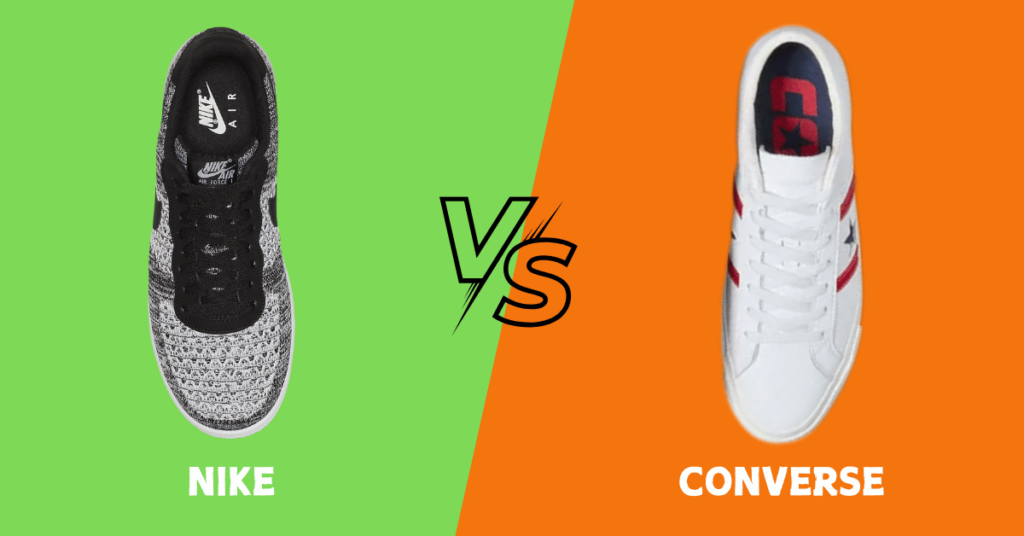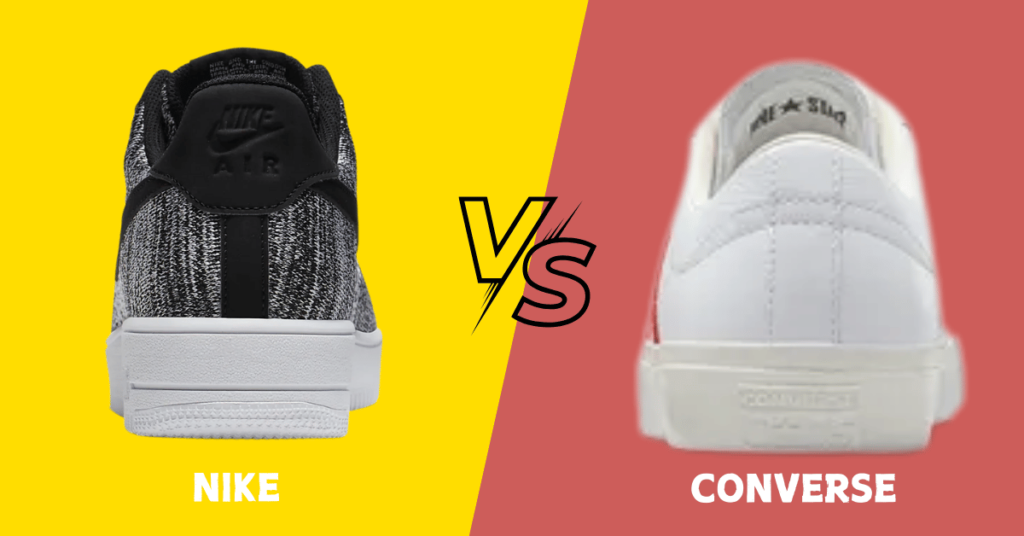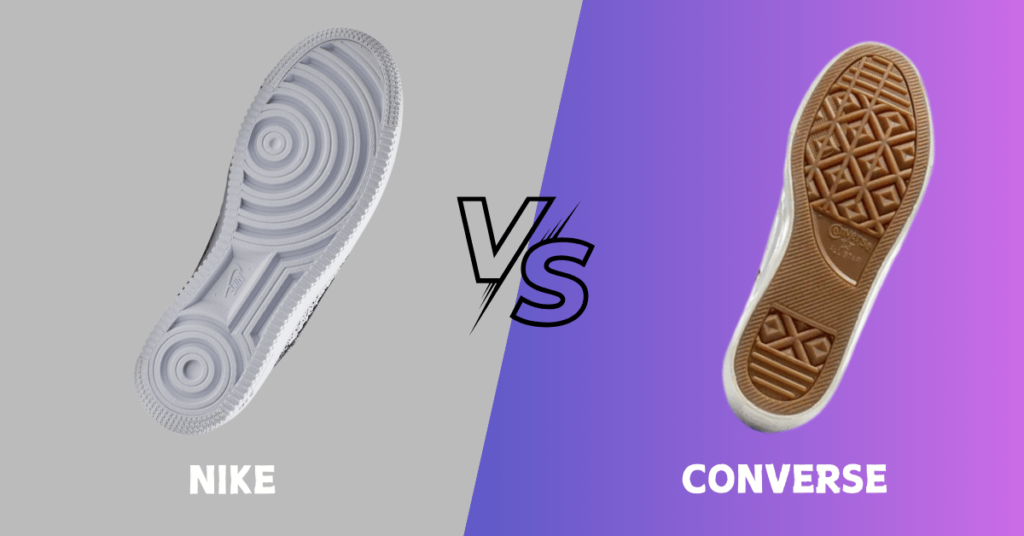Physical Address
304 North Cardinal St.
Dorchester Center, MA 02124
Physical Address
304 North Cardinal St.
Dorchester Center, MA 02124

Regarding iconic footwear, Nike vs Converse are two of the most popular brands worldwide. Each brand Nike vs Converse has its unique identity and caters to different customer preferences. Whether you’re an athlete looking for high-performance shoes or someone who loves vintage, laid-back style, this comprehensive guide will help you decide which brand suits your needs better.
In this article, we’ll explore every aspect of these two giants, including comfort, style, durability, pricing, and more.

Nike is renowned for its innovative designs, cutting-edge technology, and high-performance athletic shoes. The brand’s global reach and association with professional sports make it a favorite among athletes and fitness enthusiasts.
Conversely, Converse has carved out a niche with its classic, timeless designs like the Chuck Taylor All-Star and One Star. Converse shoes represent simplicity and nostalgia, making them a go-to choice for casual wear.
Let’s break down Nike vs Converse differences across key categories to help you make an informed decision.
When it comes to choosing the right footwear, comfort is a crucial factor that sets brands apart. Both Nike vs Converse offer distinct approaches to comfort, catering to different preferences and lifestyles.
Nike shoes are engineered with advanced cushioning systems like Air Max, Zoom Air, and React Foam. These technologies ensure optimal shock absorption, reducing fatigue during high-impact activities like running, basketball, or gym workouts. Additionally, Nike’s focus on ergonomic designs provides excellent arch support, making their shoes suitable for long hours of wear.
Converse shoes have a minimalist design, featuring flat soles and minimal padding. While this makes them lightweight and easy to wear for short periods, they lack the advanced cushioning needed for extended use or strenuous activities. Converse shoes are ideal for casual outings but may not provide the same comfort level as Nike’s performance-oriented models.
| Category | Nike | Converse |
|---|---|---|
| Cushioning | Advanced (Air Max, React Foam) | Minimal, flat soles |
| Best For | Sports, long wear | Casual, short wear |
| Arch Support | Excellent | Limited |
When comparing style and design, Nike vs Converse showcase unique aesthetics that appeal to diverse tastes, making them standout choices for different fashion preferences.
Nike shoes are designed for the modern athlete and fashion enthusiast. They come in a variety of bold, futuristic designs and vibrant colors, making them versatile for both performance and style. Nike often collaborates with athletes, designers, and celebrities to release exclusive collections that resonate with a younger, trend-conscious audience.
Converse is synonymous with timeless, retro style. Models like the Chuck Taylor All-Star and One Star have remained virtually unchanged for decades, making them a staple in the wardrobes of people who appreciate vintage fashion. Converse shoes pair effortlessly with casual outfits, offering a classic yet laid-back vibe.
| Feature | Nike | Converse |
|---|---|---|
| Aesthetic | Modern, sporty | Retro, vintage |
| Target Audience | Athletes, trendsetters | Casual, everyday users |
| Customization | Available in many models | Limited customization |

Understanding sizing consistency is essential when choosing between Nike vs Converse, as each brand follows its fit guidelines to cater to different foot shapes and preferences.
Nike shoes typically run true to size, although some models are designed with a snug fit to enhance performance. Athletes with wider feet may need to size up for maximum comfort.
Converse shoes tend to run large. Many users recommend sizing down by half a size to achieve the perfect fit. The brand’s flat sole and minimal design mean there’s less flexibility in terms of fit adjustments.
The brand reputation of Nike vs Converse reflects its legacy and impact, with each standing out for its unique contributions to the footwear industry.
Nike is a powerhouse in the sportswear industry. With endorsements from legendary athletes like Michael Jordan, Serena Williams, and Cristiano Ronaldo, the brand represents innovation, performance, and quality. Nike’s commitment to sustainability and inclusivity further enhances its reputation.
Converse holds a special place in the hearts of those who love classic and nostalgic designs. The brand’s cultural significance extends beyond footwear, as it has been embraced by artists, musicians, and skaters for decades.
When it comes to breathability, Nike vs Converse takes different approaches, offering options that cater to varying needs for ventilation and comfort.
Nike incorporates breathable materials like mesh uppers and perforated designs in many of its models. These features promote airflow, keeping feet cool and dry during physical activities.
Converse shoes are made with canvas uppers, which provide decent breathability. However, the lack of advanced ventilation features means they may not perform as well as Nike in hot or humid conditions.

Durability plays a key role in footwear selection, and both Nike vs Converse offer unique strengths to ensure lasting quality for their respective uses.
Nike shoes are built for durability, particularly in performance-focused models. Features like Flyknit uppers, durable rubber outsoles, and reinforced stitching ensure that Nike shoes can withstand heavy use.
Converse shoes are durable for casual wear, but their canvas construction and simpler designs make them less suitable for rigorous activities. Over time, the canvas may show signs of wear, especially with regular outdoor use.
| Factor | Nike | Converse |
|---|---|---|
| Material Durability | High-tech, long-lasting | Sturdy but limited for sports |
Fit and support are vital for ensuring comfort and foot health, and Nike vs Converse provide distinct options tailored to different needs and activities.
Nike shoes are designed to provide superior fit and support. Features like padded collars, arch support, and adaptive cushioning make them ideal for athletes and people with specific foot needs.
Converse shoes have a simple structure that lacks advanced support features. While they fit well for casual use, they may not be the best option for those needing extra support for flat feet or high arches.
Pricing is an important factor to consider when choosing between Nike vs Converse, as each brand offers footwear at varying price points based on design, technology, and intended use.
| Brand | Price Range |
|---|---|
| Nike | $60 – $250+ |
| Converse | $50 – $100 |
Nike shoes are generally more expensive, reflecting their advanced technology and premium materials. Converse offers budget-friendly options, making them accessible to a broader audience.
Customer reviews play a significant role in understanding the true value of Nike vs Converse shoes, offering insights into comfort, durability, and overall satisfaction from real users.
Customers often praise Nike for its:
However, some users mention that Nike shoes can feel narrow, and the higher price point may deter budget-conscious buyers.
Converse receives positive reviews for:
On the downside, customers occasionally note the lack of cushioning and arch support as areas for improvement.

Both Nike vs Converse have carved their niches in the footwear market, offering distinct advantages based on your preferences:
Ultimately, your choice depends on your lifestyle and needs. Both brands Nike vs Converse deliver quality and have loyal followings for a reason.
Yes, Nike shoes are designed with performance-enhancing features, making them better suited for sports. Converse shoes are more appropriate for casual wear.
No, Converse shoes often run large. It’s recommended to size down by half a size for a snug fit.
For those seeking high performance, comfort, and durability, Nike shoes are worth the investment.
Nike shoes are generally more durable for rigorous use, while Converse shoes are sturdy for casual wear but may wear out faster under heavy use.
Converse lacks the cushioning and support needed for running or other high-impact activities. It’s better suited for walking or casual wear.